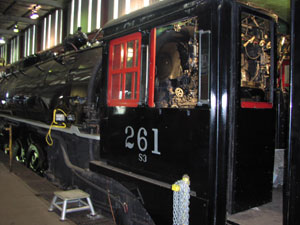|
Audio
Photos
Resources
Your Voice
|
Trains of the past restored to life
October 20, 2003
 |
| The 261 coal-burning steam locomotive rests in the machine shop. (MPR Photo/Elizabeth Stawicki) |
Minneapolis, Minn. — In northeast Minneapolis, a lonely train track appears to go nowhere -- at least nowhere special. The track snakes under a non-descript, two-story windowless building that looks like a big warehouse from the outside. But venture inside and the hum of florescent lights and the sound of machinery hint that this is a mechanical shop.
 | |||
The shop cradles a resting giant -- a black, coal-burning steam locomotive weighing nearly 500 tons. Its wheels alone are more than six feet tall.
"Step right up here in the locomotive cab," says Steven Sandberg, the locomotive's engineer who heads up the Friends of 261, a group of volunteers who restore vintage railroad cars. To get this engine rolling down the track is a major undertaking. Because the locomotive is all metal, the engine actually expands about one inch when it heats up.
"It takes almost 24 hrs to heat the locomotive up and you can't do it too fast or the metal will fatigue and break. They were designed to do that. It literally is a living, breathing machine," Sandberg says.
The "Friends of 261" gives tens of thousands of hours to restore about two dozen railcars into shape. Most volunteers, like Sandberg, have some family connection to trains or like Jim Redeske, possess a romantic obsession with transportation from the past. Today he's got the not-so-glamorous job of cleaning the duct work inside one of the several rail cars. Redeske is a retired Vice President from Northwest Airlines.
"Ever since I was a young boy I had a tremendous fascination with large steam locomotives. Sure I could buy a ticket and ride the train, but I'd rather be part of it and make it happen rather than standing around," Redeske says.
 | |||
The organization operates on donations and from selling tickets for public excursions on the restored trains a few times per year. It's acquired 23 railcars ranging from the 261 locomotive to lounge cars to coach cars to sleeping cars. In sleeping cars, the tight quarters are reminiscent of Eva Marie Saint's room in the movie, "North by Northwest". The one in which Cary Grant hid in one of the upper berths that fold into the wall.
Kevin Swanson, a Fridley firefighter, began restoring the trains through the organization five years ago after he literally chased the 261 locomotive in northern Minnesota.
"Who'd ever think that in 2003 we'd be running a coal-fired engine down the track; it's just unheard of. On a particular day, I heard about the train and we were travelling from Superior, Wisconsin to Fargo, North Dakota. So I said to the wife, 'let's get in the car and go; if we leave now we should catch it in Brainerd.' Got to Brainerd and they had just left town," says Swanson.
Engineer Steve Sandberg's connection to trains stems from his grandfather who worked for the Milwaukee Road for 53 years. But for others the connection isn't quite as apparent. Sandberg remembers a day when the crew was working in the train yard getting cars ready for an upcoming trip when Sandberg noticed a couple in their late 80's sitting in one of the organization's jewels: the skytop, a lounge observation car that has a round end encased in glass.
"I happened to be walking by the car and saw something out of the corner of my eye and peaked over and here was this elderly man and his wife in the car having a little picnic in there. They were just sitting in there and we can only imagine what they were thinking of but I'm sure it was some sort of fond memory," he says.
Sandberg says none of the volunteers bothered the couple who finished their picnic, cleaned up and left. They never saw them again.
|
News Headlines
|
Related Subjects
|
